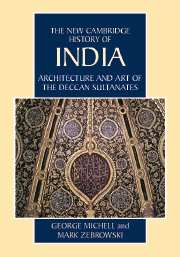Book contents
- Frontmatter
- Introduction
- 1 Historical framework
- 2 Forts and palaces
- 3 Mosques and tombs
- 4 Architectural decoration
- 5 Miniature painting: Ahmadnagar and Bijapur
- 6 Miniature painting: Golconda and other centres
- 7 Textiles, metalwork and stone objects
- 8 Temples
- 9 Conclusion
- Appendix: Dynastic Lists of Deccan Rulers
- Bibliographic Essay
- Bibliography
- Index
- Map of the Southern Deccan"
- Plate Section"
5 - Miniature painting: Ahmadnagar and Bijapur
Published online by Cambridge University Press: 28 March 2008
- Frontmatter
- Introduction
- 1 Historical framework
- 2 Forts and palaces
- 3 Mosques and tombs
- 4 Architectural decoration
- 5 Miniature painting: Ahmadnagar and Bijapur
- 6 Miniature painting: Golconda and other centres
- 7 Textiles, metalwork and stone objects
- 8 Temples
- 9 Conclusion
- Appendix: Dynastic Lists of Deccan Rulers
- Bibliographic Essay
- Bibliography
- Index
- Map of the Southern Deccan"
- Plate Section"
Summary
ahmadnagar
The briefest and most mysterious phase of Deccani painting occurred at the late sixteenth-century court of Ahmadnagar. Brief, because, all told, it lasted barely three decades; mysterious, because we know nothing of its antecedents nor its aftermath, nor even the identities of its principal artists and patrons. All that survive are the illustrations to a historical manuscript which can be considered the ‘preclassical’ phase of the school, three great ‘classical’ portraits of remarkable power, these latter amongst the most profound and subtle images India has produced, and a handful of drawings which, although fine works of art in their own right and obviously related to the three great portraits in style and costume, do not quite measure up to them in expressive power. This artistic tradition – if a school of such short duration can be termed a tradition – was a mere flash of artistic brilliance, snuffed out by the Mughal conquest in 1600. We assume of course that the original production of art at Ahmadnagar was substantially larger than what has survived the vicissitudes of history, though we doubt that any of the Deccani centres approached in quantity the output of the Mughal school.
The Nizam Shahis were the ruling dynasty, and three sultans seem to have been generous patrons: Husain and his sons Murtaza I and Burhan II. The earliest surviving paintings illustrate a manuscript of the history of the reign of Husain; the text composed by Aftabi, entitled the Tarif-i Husain Shahi, is now in the Bharata Itihasa Samshodhaka Mandala, Pune. Husain led the alliance with the sultans of Golconda, Bijapur and Bidar which defeated the Hindu empire of Vijayanagara in January 1565. He died five months later. The Tarif praises Husain and his wife Khanzada Humayun, describes the defeat of the Vijayanagara army, but does not mention the sultan’s death. We conclude that the manuscript was produced in about 1565, between the sultan’s victory and his death.
- Type
- Chapter
- Information
- Architecture and Art of the Deccan Sultanates , pp. 145 - 190Publisher: Cambridge University PressPrint publication year: 1999

